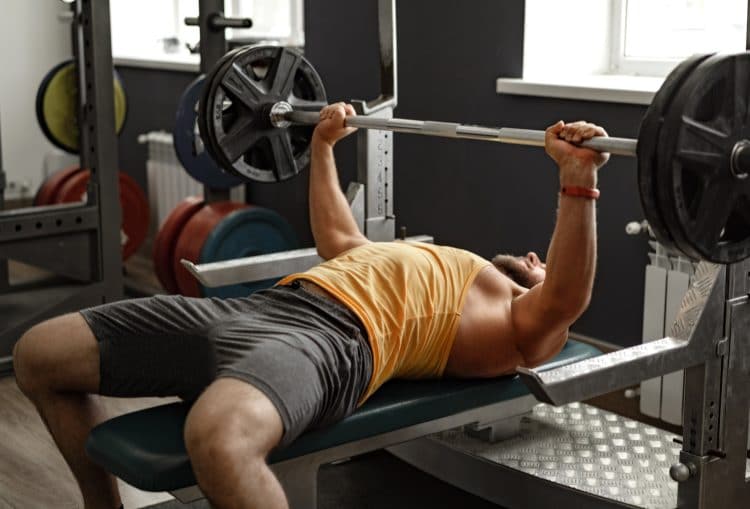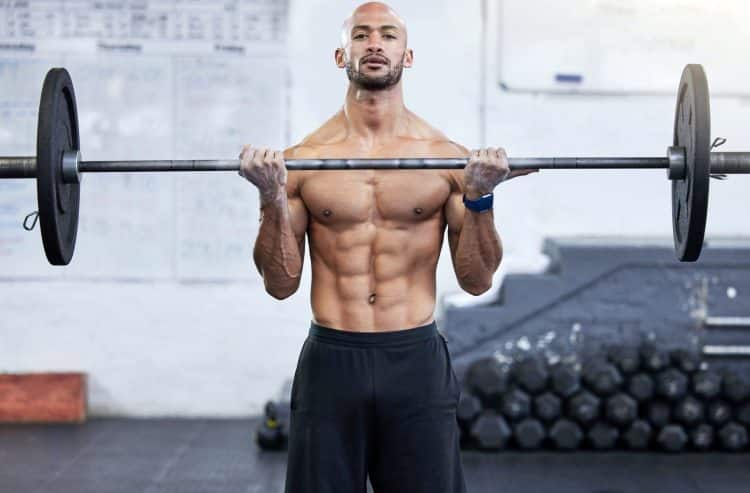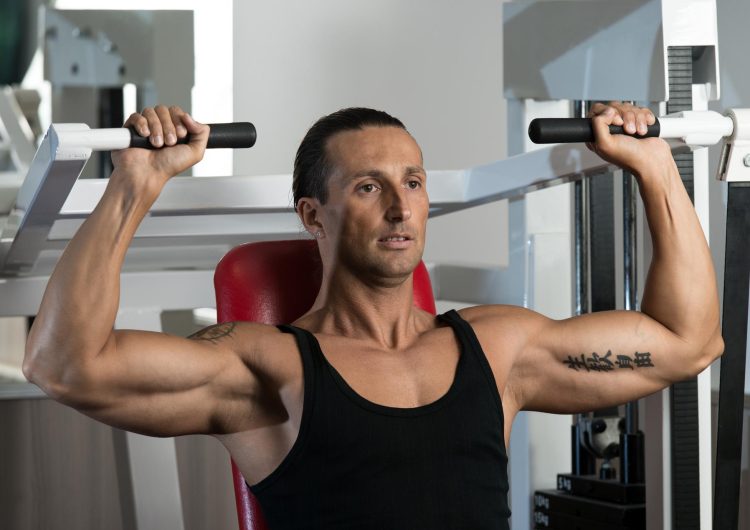I’ve been a personal trainer for over 30 years. During that time, I’ve helped lots of people achieve their bodybuilding dreams, including my wife, who won the first bodybuilding show she ever entered.
Bodybuilding coaching involves various elements, including diet planning, workout supervision, and physique presentation. However, the part of the job I enjoy the most is designing effective training programs.
While some bodybuilders make good progress without a program, using what is known as the instinctive training principle, I’m not a fan. Training without a program leaves too much to chance. You might get good results, but equally, you might not.
Training programs are like maps – they help you get to where you want to go as quickly and efficiently as possible. Following a training program ensures that every workout, exercise, set, and rep takes you one step closer to your ultimate goal – a powerful, strong, lean physique.
I’ve written hundreds of bodybuilding training workouts. Still, I also like to read and follow programs by other coaches. This exposes me to new ideas and helps me to create even better workouts for my articles and army of personal training clients.
In this article, I share what I believe are the three most intense training programs for advanced bodybuilders.
Level Up Your Fitness: Join our 💪 strong community in Fitness Volt Newsletter. Get daily inspiration, expert-backed workouts, nutrition tips, the latest in strength sports, and the support you need to reach your goals. Subscribe for free!
The 3 Most Intensive Bodybuilding Programs
I’ve read and tried almost every popular bodybuilding workout you can think of, and these are the three that I believe are the most intensive. Be warned – these programs are not for the faint of heart, and you should only attempt them if you have several years of consistent training experience behind you.
1. Power Hypertrophy Adaptive Training (PHAT)
Power Hypertrophy Adaptive Training (PHAT) is the brainchild of bodybuilder and powerlifter Layne Norton. Norton is a 20-year veteran fitness personality with a BS in biochemistry and a Ph.D. in nutritional sciences.
The PHAT program combines heavy strength and classic hypertrophy training to build dense, powerful muscles. In other words, you won’t just look strong but will BE strong, too. As such, PHAT can be thought of as a powerbuilding program.
However, with five workouts per week, and an emphasis on heavy weights, this is a challenging program that’s only really suitable for experienced lifters with proven recovery abilities.
PHAT Basics
- Five weekly workouts – two heavy “power” and two lighter hypertrophy workouts.
- Begin each workout with an appropriate warm-up.
- Train all major muscles with a variety of exercises/modalities to work them from all available angles.
- Train each muscle with heavy weights for low reps, moderate weights for medium reps, and low weights for high reps to target all muscle fiber types.
- Follow the program for 8-12 weeks before deloading/resetting.
- Combine PHAT training with a kilocalorie surplus, i.e., a bulking diet.
- Minimize cardio – save your energy for lifting, recovering, and growing.
Training Schedule
As mentioned, PHAT involves a five-day workout schedule. This is a high-volume/high-frequency training program, so a sound diet and attention to rest and recovery are critical.
- Monday: Upper Body Power
- Tuesday: Lower Body Power
- Wednesday: Rest
- Thursday: Back and Shoulders Hypertrophy
- Friday: Lower Body Hypertrophy
- Saturday: Chest and Arms Hypertrophy
- Sunday: Rest
Example PHAT Workouts
There are numerous versions of PHAT, including Norton’s “official” program, available here. However, here is a PHAT-inspired example program to get you started.
Workout 1: Upper Body Power
| Exercise | Sets | Reps | |
| 1 | Barbell bench press | 3 | 3-5 |
| 2 | Weighted pull-up | 3 | 3-5 |
| 3 | Incline DB bench press | 2 | 6-10 |
| 4 | Chest-supported row | 2 | 6-10 |
| 5 | Barbell military press | 3 | 6-10 |
| 6 | Barbell biceps curl | 2 | 6-10 |
| 7 | Weighted dip | 2 | 6-10 |
Workout 2: Lower Body Power
| Exercise | Sets | Reps | |
| 1 | Barbell squat | 3 | 3-5 |
| 2 | Rack pull | 3 | 3-5 |
| 3 | Leg press | 2 | 6-10 |
| 4 | Romanian deadlift | 2 | 6-10 |
| 5 | Leg extension | 2 | 6-10 |
| 6 | Leg curl | 2 | 6-10 |
| 7 | Standing calf raise | 2 | 6-10 |
Workout 3: Back and Shoulders Hypertrophy
| Exercise | Sets | Reps | |
| 1 | Lat pulldown (wide) | 3 | 8-12 |
| 2 | Seated row | 3 | 8-12 |
| 3 | Lat pulldown (close) | 2 | 12-15 |
| 4 | Single-arm row | 2 | 12-15 |
| 5 | Seated DB press | 3 | 8-12 |
| 6 | Cable lateral raise | 2 | 12-15 |
| 7 | Cable face pull | 2 | 12-15 |
Workout 4: Lower Body Hypertrophy
| Exercise | Sets | Reps | |
| 1 | Leg press | 3 | 8-12 |
| 2 | Hack squat | 2 | 12-15 |
| 3 | Alternating lunge | 3 | 8-12 |
| 4 | Leg extension | 2 | 12-15 |
| 5 | Leg curl | 2 | 12-15 |
| 6 | Seated calf raise | 3 | 10-15 |
| 7 | Standing calf raise | 3 | 15-20 |
Workout 5: Chest and Arms Hypertrophy
| Exercise | Sets | Reps | |
| 1 | Dumbbell bench press | 3 | 8-12 |
| 2 | Incline barbell press | 3 | 8-12 |
| 3 | Pec deck | 2 | 12-15 |
| 4 | Push-ups | 2 | 15-20+ |
| 5 | Cable preacher curl | 3 | 8-12 |
| 6 | Concentration curl | 2 | 12-15 |
| 7 | Triceps pushdown | 3 | 8-12 |
| 8 | Overhead triceps extension | 2 | 12-15 |
PHAT Conclusion
PHAT is a proven program for building muscle and strength. Its high-frequency/high-volume workouts will push you to your limits.
However, while undeniably effective, this program requires a significant time commitment, and you’ll need to find at least 90 minutes five days a week to follow this plan. But if you have the time and energy to stick with it, you’ll be rewarded with impressive increases in strength and muscle size.
2. Classic Push-Pull-Legs (PPL) Program
Intensive bodybuilding workouts are nothing new. In fact, one of the most demanding workouts is also one of the oldest – the old-school 20-rep squat routine. However, while the 20-rep squat program is a killer, in my opinion, the classic push-pull-legs program is even tougher.
Known as PPL, this workout has been used by bodybuilders since the early 1960s and was a favorite of many golden-era champions, including Arnold Schwarzenegger, Frank Zane, and Franco Columbu. The PPL program is also popular with many of today’s athletes, such as Chris Bumstead and Jay Cutler.
So, while there are plenty of newer programs that build muscle, the classic push-pull-legs program is a part of bodybuilding history. The reason for its lasting popularity is simple – it works!
Classic PPL Basics
- Divide your muscles into three groups: Push (chest, shoulders, triceps), pull (back and biceps), and legs (quads, hamstrings, glutes, calves).
- Include a variety of exercises for each muscle group, including compound and isolation movements.
- Train six days per week, hitting each group of muscles twice.
- Use medium to high reps and keep your rests short to maximize the pump.
- Use training-intensifying methods to make your workouts even more demanding.
- Play plenty of attention to rest and recovery.
Training Schedule
The PPL program gets its name from your training schedule. While you could change the order of the days, there is no benefit to doing so. Bodybuilders have been building muscle with PPL for over 50 years, strongly suggesting this workout sequence is effective.
Level Up Your Fitness: Join our 💪 strong community in Fitness Volt Newsletter. Get daily inspiration, expert-backed workouts, nutrition tips, the latest in strength sports, and the support you need to reach your goals. Subscribe for free!
- Monday – Push
- Tuesday – Pull
- Wednesday – Legs
- Thursday – Push
- Friday – Pull
- Saturday – Legs
Example Workouts
There are lots of versions of the PPL program, and you are free to interpret this popular training program in any way you wish. Just create three workouts by grouping push, pull, and leg exercises together.
But, to save you the time and bother, here is an example push-pull-legs workout to try. Do each workout twice, as shown in the training schedule above. Alternatively, write three more programs using different exercises and do them during the latter half of your training week.
Push Workout
| Exercise | Sets | Reps | |
| 1 | Smith machine bench press | 3 | 8-15 |
| 2 | Incline dumbbell press | 3 | 8-15 |
| 3 | Cable crossover | 3 | 8-15 |
| 4 | Dips | 3 | 8-15 |
| 5 | Barbell shoulder press | 3 | 8-15 |
| 6 | Dumbbell lateral raise | 3 | 8-15 |
| 7 | Dumbbell front raise | 3 | 8-15 |
| 8 | Triceps pushdown | 3 | 8-15 |
| 9 | Dumbbell kickback | 3 | 8-15 |
Pull Workout
| Exercise | Sets | Reps | |
| 1 | Chin-up | 3 | 8-15 |
| 2 | Seated row | 3 | 8-15 |
| 3 | Lat pulldown | 3 | 8-15 |
| 4 | Pullover | 3 | 8-15 |
| 5 | Barbell curl | 3 | 8-15 |
| 6 | Spider curl | 3 | 8-15 |
| 7 | Wrist curl | 3 | 8-15 |
Legs Workout
| Exercise | Sets | Reps | |
| 1 | Front squat | 3 | 8-15 |
| 2 | Leg extension | 3 | 8-15 |
| 3 | Still-leg deadlift | 3 | 8-15 |
| 4 | Leg curl | 3 | 8-15 |
| 5 | Leg press | 3 | 8-15 |
| 6 | Walking lunge | 3 | 8-15 |
| 7 | Seated calf raise | 3 | 8-15 |
| 8 | Standing calf raise | 3 | 8-15 |
PPL Conclusion
The classic PPL is a time-honored program combining high-volume training and high-frequency workouts. While tiring and time-consuming, this is a proven way to build muscle. However, you must pay attention to your diet and recovery, or you’ll quickly become over-trained.
PPL has been around for over half a century, which tells us one thing – it works! Some of the biggest names in bodybuilding have used this program, and if it worked for them, it could work for you, too. That said, only attempt the PPL program if you have been training for a few years. It’s definitely not suitable for beginner or early intermediate lifters.
3. DoggCrapp (DC)
Forget the name of this program and get your head around this little fact – not all super-intensive bodybuilding programs require 5-6 long workouts per week. In fact, DoggCrapp, or, more politely, DC, promises great results from just three short workouts per week.
However, make no mistake – those workouts are intensive, and you will have to suffer for your gains.
DoggCrapp was invented by bodybuilder and fitness personality Dante Trudel, and the name comes from the handle he used to use on online fitness forums. Trudel has since said that if he had known how popular his program would become, he’d have called it something else.
The DC program combines several proven workout methods, including rest-pause, myo-reps, and loaded stretching to maximize hypertrophy in minimal time.
DC Training Basics
- Train three times a week using an A/B workout schedule, e.g., push/pull or upper/lower.
- Choose one exercise per muscle group.
- Do one working set per exercise.
- Complete 11-15 reps per exercise. Aim for an initial 6-9 reps and accumulate the remaining reps rest-pause style.
- Rotate exercises every workout.
- Perform a weighted stretch for 60-90 seconds for each muscle immediately after training it.
- Utilize progressive resistance by adding weight or striving for more reps week by week.
Training Schedule
DC inventor Dante Trudel suggests creating three A programs and three B programs and doing them in rotation. This approach allows you to hit your muscles from a variety of angles while avoiding boredom.
For example:
- A Workout = Upper body or push
- B Workout = Lower body or pull
| Monday | Wednesday | Friday | |
| Week 1 | A1 | B1 | A2 |
| Week 2 | B2 | A3 | B3 |
| Week 3 | A1 | B1 | A2 |
| Week 4 | B2 | A3 | B3, etc. |
Example DC Workouts
Despite some pretty specific guidelines, DC training is actually very straightforward. This simplicity frees you up to focus on pushing your muscles to their limit.
Here are two example workouts to try:
Workout A
| Exercise | Sets x Reps | |
| 1 | Barbell bench press | 1 x 11-15 |
| 2 | Weighted DB fly chest stretch | 60-90 seconds |
| 3 | Hammer row | 1 x 11-15 |
| 4 | Dead hang | 60-90 seconds |
| 5 | Shoulder press machine | 1 x 11-15 |
| 6 | Weighted cable side lateral stretch | 60-90 seconds |
| 7 | EZ bar skull crusher | 1 x 11-15 |
| 8 | Weighted overhead triceps stretch | 60-90 seconds |
Workout B
| Exercise | Sets x Reps | |
| 1 | Smith machine squat | 1 x 11-15 |
| 2 | Sissy squat quads stretch | 60-90 seconds |
| 3 | Leg curl | 1 x 11-15 |
| 4 | Romanian deadlift weighted stretch | 60-90 seconds |
| 5 | Standing calf raise | 1 x 11-15 |
| 6 | Weighted calf stretch | 60-90 seconds |
| 7 | Seated dumbbell curls | 1 x 11-15 |
| 8 | Seated incline weighted biceps stretch | 60-90 seconds |
Remember, for each strength training exercise, select a weight that will cause you to fail within 6-9 reps. On reaching failure, rest for 15-20 seconds and then pump out a couple more reps. Rest again and then complete the remaining reps. Strive to increase your weights week by week.
DC Training Conclusion
DoggCrapp (gotta love that name!) is the opposite of most bodybuilding programs. Instead of hammering your muscles with lots of volume, it emphasizes intensity. While you only do one set per exercise, that set takes your muscles to failure three times in the space of a couple of minutes.
Combined with weighted stretches, this results in shorter, less frequent workouts that many lifters will find appealing. So, if you find higher-volume programs like push-pull-legs and PHAT impractical or hard to recover from, DC training could be a viable option.
Closing Thoughts
You can make any workout more intensive by using heavy weights, taking your sets to failure, and using drop sets, forced reps, and other intensity-boosting methods. Even a beginner’s program can be modified to make it more challenging.
That said, PHAT, PPL, and DC are tough right out of the gate. They don’t need any modifications to make them more challenging – they’re already designed to kick your butt!
Use these workouts to take your gains to the next level. But be warned, they’re going to break you down before they build you up. Only attempt these programs if you’ve got all your nutrition and recovery ducks in a row. Even then, keep an eye out for overtraining and use deloads to prevent burnout.











